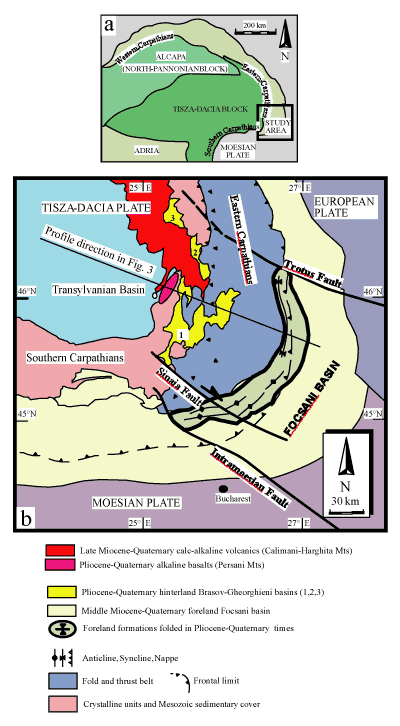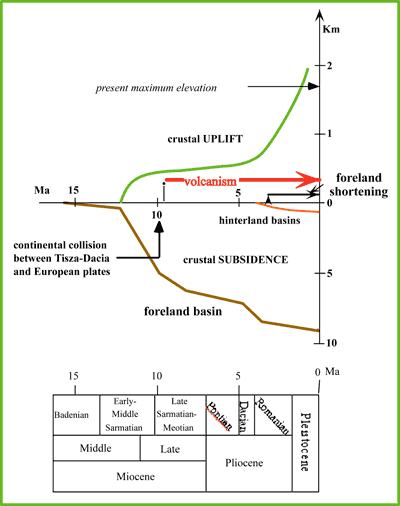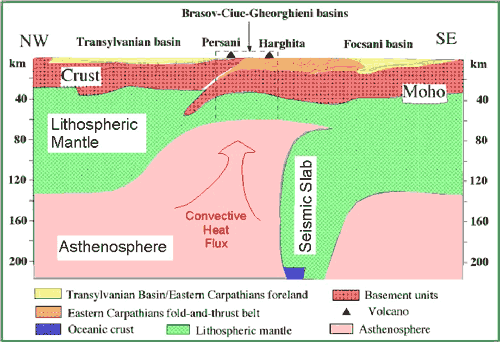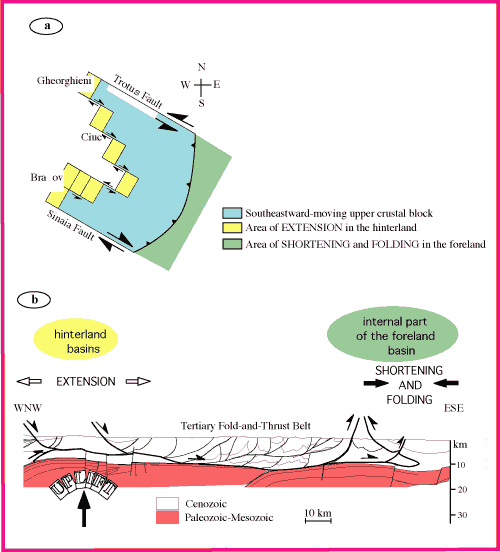 |
How
to Generate Late-Collision, Calc-Alkaline
and Alkaline, Mafic Volcanism
|
|
|
|
Partial delamination of continental
mantle lithosphere, uplift-related crust-mantle decoupling,
volcanism and basin formation: a new model
for the Pliocene-Quaternary evolution of the southern
East-Carpathians, Romania |
|
|
We propose a geodynamic model for the Mid-Miocene
to Quaternary evolution of the southern East-Carpathians
(Figure 1) in order to explain the relationships between
shallow and deep geological phenomena that occurred
synchronously during late-collision tectonics (Chalot-Prat
& Girbacea, 2000).
|

Figure 1: a. Tectonic blocks
(ALCAPA and Tisza-Dacia) whose convergence and continental
collision with the European Plate resulted in the
formation of the Carpathian arc during Tertiary times
(after Csontos, 1995); b. Location of the study area
in the southern Eastern Carpathians (simplified after
Girbacea & Frisch, 1998). Click to enlarge.
In this area, an active volcanic
zone has cross-cut, for the last 2 My, the suture
between the overriding Tisza-Dacia and subducting
European continental plates. Mafic calc-alkaline and
alkaline magmas (the south Harghita and Persani volcanoes)
erupted contemporaneously.
|
 |
These magmas were supplied by partial
melting of the subcrustal heterogeneous mantle lithosphere
of the subducting, and not the overriding, plate (Chalot-Prat
& Boullier, 1997). This shallow mantle lithosphere
corresponds to a residual mantle which recorded at
least two distinct events of metasomatism well before
the eruptions.
In an effort to decipher this setting of magma
generation, the spatial and temporal distribution
of shallow and deep phenomena (Figure 2) were
examined in order to establish the degree of
their interdependence. Our model indicates that
intra-mantle delamination of the subducting
European plate is the principal cause of a succession
of events (Figure 3). It caused upwelling of
the hot asthenosphere below the thinned continental
lithosphere of the Carpathians, inducing uplift
of the lithosphere and internal decoupling at
the Moho by isostatic and thermal effects.
Figure 2: Timing of successive and coeval
surface events in the southern Eastern Carpathians.
The different curves represent the subsidence
of Focsani foreland, the uplift of the Carpathian
chain and the hinterland subsidence leading
to the Brasov, Ciuc and Gheorghieni basFigure 1: a. Tectonic blocks
(ALCAPA and Tisza-Dacia) whose convergence and continental
collision with the European Plate resulted in the
formation of the Carpathian arc during Tertiary times
(after Csontos, 1995); b. Location of the study area
in the southern Eastern Carpathians (simplified after
Girbacea & Frisch, 1998). Click to enlarge.in formation,
while straight lines represent the age intervals
of the Late Miocene-Quaternary volcanic activity
and of shortening of the internal part of the
foreland basin. (Click on figure to enlarge.)
|
|

Figure 3: Delamination
model proposed for the Pliocene-recent evolution of
the Eastern Carpathians (after Girbacea & Frisch,
1998, modified). This model suggests that, during the
continental collision in Miocene times, break-off of
the west-dipping subducting slab occurred at a depth
of 70 km. Slab break-off propagated horizontally towards
the east, inducing lithospheric delamination, counterclock-wise
rotation of the delaminated lithospheric segment and
movement of the Vrancea slab (seismically active due
to ongoing pull of the oceanic lithosphere) into its
present position. Location of Figure 4b is shown for
a better understanding of the model. Click on figure
for a larger version.
|
During this uplift, the crust deformed flexurally
while the mantle deformed in a ductile way. This triggered
decompressional partial melting of the uppermost mantle
lithosphere (Figure 4). Flexural deformation of the
crust induced transient fracturing, allowing for the
rapid ascent of magmas to the surface, as well as
reactivation of an older detachment horizon at the
base of the Carpathian nappe stack. Above this, the
Brasov, Ciuc and Gheorghieni hinterland basins formed
by extension and gravity spreading (Figure 5). The
rapid subsidence of the Focsani foreland basin (Figure
2) is controlled by the load exerted on the lithosphere
by the delaminated mantle slab that is still attached
to it (Figure 3).
|

Figure 4: Geodynamic model explaining
lithospheric uplift, volcanism and basin formation
in the southern East Carpathians during the Late Miocene-Quaternary
times. (a) SW-NE profile shows fracturing of the crust
leading to volcanic eruptions; (b) NW-SE profile shows
upper crustal detachment leading to hinterland basin
formation by gravity speading. The succession of events
is: 1- asthenospheric upwelling, itself induced by
delamination of the lower part of the lithospheric
mantle (see Figure 3); 2- density decrease and temperature
increase of the overlying lithosphere leading to its
uplift; 3- mantle-crust mechanical decoupling at the
MOHO level due to the density gap between mantle and
crust and their different rheological behaviour; crust
bends and fractures, while mantle deforms in a ductile
way, undergoes decompression and partial melting;
4a- injection under pressure of magmas throughout
crustal fracturing and eruption at the surface; 4b-
crustal extension and remobilization, in the upper
crust, of an old detachment horizon above which hinterland
basins form by gravity spreading towards the SE (see
Figure 5).
|

Figure 5: a. Kinematic model
of the Brasov-Gheorgieni basin formation and foreland
folding. The uplift-induced southeastward motion of
a crustal block between two strike-slip faults (Trotus
and Sinaia) resulted in extension and basin formation
in the hinterland, accommodated by coeval shortening
in the foreland (see Figure 1 in Girbacea et al.,
1998); b. the crustal motion has taken place above
a detachment horizon within the fold-and-thrust belt
(after Girbacea & Frisch, 1998 and Girbacea et
al., 1998, modified).
|
| In this model, crust-mantle decoupling,
magma genesis, volcanism and local, near-surface hinterland
extension are consequences of uplift induced by asthenospheric
upwelling triggered by intra-mantle delamination.
This model suggests that delamination-induced
decoupling began to be efficient 9.4 My ago at the northern
end of the East-Carpathians, when the mantle slab dipped
westwards. Subsequently, intra-mantle delamination migrated
laterally, normal to the slab strike, and followed the
arcuate shape (NW–>SE–>SW) of the
Carpathians. Nowadays, whereas the mantle slab is still
actively foundering below the Vrancea seismic zone to
the SE of the most recently volcanic area (South Harghita
- Persani), a significant southwestward shift of the
delamination process can be discerned.
|
-
Chalot-Prat, F. and Boullier,
A.M., 1997. Metasomatic events in the subcontinental
mantle beneath the Eastern Carpathians (Romania):
new evidences from trace elements. Cont. Min.
Pet., 129, 284-307.
-
-
Downes, H., Seghedi, I., Szakacs,
A., Dobosi, G., James, D.E., Vaselli, O., Rigby,
I.J., Ingram, G.A., Rex, D. and Pecskay, Z., 1995.
Petrology and geochemistry of late Tertiary/Quaternary
mafic alkaline volcanism in Romania. Lithos,
35, 65-82.
-
Fan, G., Wallace, T.C., Zhao,
D., 1998. Tomographic imaging of deep velocity structure
beneath the Eastern and Southern Carpathians, Romania:
Implications for continental collision. J. Geophys.
Res., 103, B2, 2705-2723.
-
Gîrbacea , R., 1997. The
Pliocene to recent tectonic evolution of the Eastern
Carpathians (Romania). Tübinger Geowissenschaftliche
Arbeiten : 1997, pp. 136
-
Gîrbacea , R., Frisch,
W., 1998. Slab in the wrong place: Lower lithospheric
mantle delamination in the last stage of the Eastern
Carpathian subduction retreat. Geology,
26/7, 611-614
-
Gîrbacea, R., Frisch, W.,
Linzer, H.-G., 1998. Post-orogenic uplift-induced
extension: a kinematic model for the Pliocene to
recent tectonic evolution of the Eastern Carpathians
(Romania). Geol. Carpathica, 49/5,
p. 315-327
-
Matenco, L., 1997. Tectonic
evolution of the Outer romanian Carpathians: constraints
for kinematic analysis and flexural modelling.
PhD. Thesis, Vrije Universiteit, Faculty of Earth
Sciences, Amsterdam, 160 pp.
-
Matenco, L., Zoetemeijer, R.,
Cloetingh, S. and Dinu, C., 1997. Lateral variations
in mechanical properties of the Romanian external
Carpathians: inferences of flexure and gravity modelling.
Tectonophysics, 282, 147-166.
-
Minissale, A., Vaselli, O., Tassi,
F., Seghedi, I., Magro, G. and Ioane, D., 1999.
Fluid sources in orogenic areas, two examples: Northern
Apennines and Eastern Carpathians. Rom. J. Tect.
Reg. Geol., 77/1, 33.
-
Mocanu, V.I. and Radulescu, F.,
1994. Geophysical features of the Romanian territory.
Rom. J. Tect. Reg. Geol., 75,
17-36.
-
Pécskay, Z., Edelstein,
O., Seghedi, I., Szakács, A., Kovacs, M.,
Crihan, M., and Bernad, M., 1995a. K-Ar datings
of Neogene-Quaternary calc-alkaline volcanic rocks
in Romania: Acta Vulcanologica, 7(2),
53-62.
-
Pécskay, Z., Lexa, J.,
Szakacs, A., Baloh, K., Seghedi, I., Konecn, V.,
Kovacs, M., Marton, E., Kaliciak, M., Széky-Fux,
V., Poka, T., Gyarmati, P., Edelstein, O., Rosu,
E. and Zec, B., 1995b. Space and time distribution
of Neogene-Quaternary volcanism in the Carpatho-Pannonian
region. Acta Vulcanologica, 7(2),
15-28
-
Radulescu, D., Cornea, I., Sandulescu,
M., Constantinescu, P., Radulescu, F. and Pompilian,
A., 1976. Structure de la croûte terrestre
en Roumanie - essai d'interprétation des
études seismiques profonds. Anuarul Institutului
de Geologie Si Geofizica, L:
5-36
-
Seghedi, I., Szakács,
A., Udrescu, C., Stoian, M., and Grabari, G., 1986,
Trace elements geochemistry of the South Harghita
volcanics (East Carpathians): calc-alkaline and
shoshonitic associations. Dari de Seama ale
Institutului de Geologie si Geofizica, 72-73,
381-397.
-
Seghedi, I. and Szakacs, A.,
1994. Upper Pliocene to Quaternary basaltic volcanism
in the Persani Mountains. Romanian J. Pet.,
76, 101-107.
-
Szakacs, A. and Seghedi, I.,
1995. The Calimani-Gurghiu-Harghita volcanic chain,
East Carpathians, Romania: volcanological features.
Acta vulcanologica, 7,
135-143.
-
ter Voorde, M., van Balen, R.T.,
Bertotti, G. and Cloething, S.A.P.L., 1998. The
influence of a stratified rheology on the flexural
response of the lithosphere to (un)loading by extensional
faulting. Geophys. J. Int., 134,
721-735.
-
Wenzel, F., Achauer, U., Enescu,
D., Kissling, E., Russo, R., Mocanu, V. and Musacchio,
G., 1998, Detailed look at final stage of plate
break-off is target of study in Romania : Am.
Geophys. Un., 48, T. Eos,
v. 79, p. 589-594.
-
Wenzel, F., Lorenz, F., Sperner,
B. and Oncescu, M., 1999. Seismotectonics of
the Romanian Vrancea Area. In: F. Wenzel (Editor),
Vrancea Earthquakes: Tectonics, Hazard and Risk
Mitigation. Kluwer, Bucharest
-
Ziegler, P.A., Cloethingh, S.
and Van Wees, J.-D., 1995. Dynamics of intra-plate
compressional deformation: the Alpine foreland and
other examples. Tectonophysics, 252:
7-59.
-
Ziegler, P.A., Van Wees, J.-D.
and Cloethingh, S., 1998. Mechanical controls on
collision-related compressional intraplate deformation.
Tectonophysics, 300: 103-129.
|
|
|
